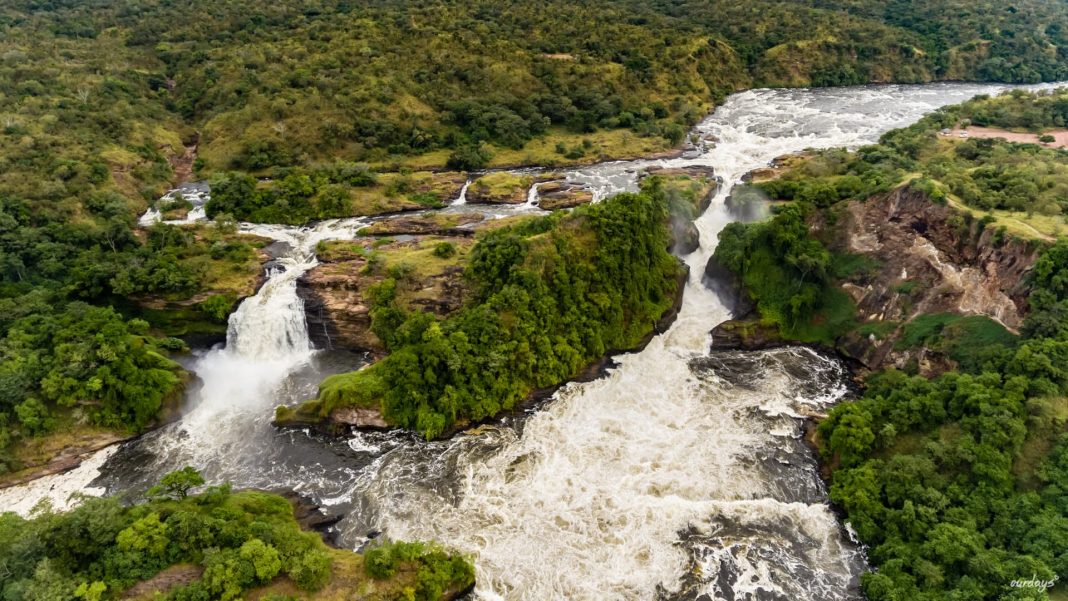After countrywide condemnation against plans to build a dam at Murchison Falls, government has now shifted its focus to nearby Uhuru Falls, according to the Minister of Energy and Mineral Development Eng. Irene Muloni who addressed the press on Tuesday about the matter.
“In order to make a scientifically informed decision, Cabinet reviewed its decision yesterday 2nd December, 2019 and agreed that a feasibility study is undertaken on the Uhuru Falls site,” she said.
According to the minister Uhuru Falls and Murchison Falls are separate falls that are adjacent to each other. Coordinates for Murchison Falls is 2016’ 22.99 N 31041’0.02 E while Coordinates for Uhuru Falls (The proposed HPP site) is 2016’ 42.6 N 31041’08.8 E.
The Government signed a Memorandum of Understanding with M/S Bonang Energy and Power Ltd from the Republic of South Africa leading a Consortium that includes among others Norconsult and JSC Institute Hydro project to undertake detailed feasibility studies.
“On 26th August 2019, Cabinet was apprised of the Power developments in the country among which was Uhuru falls and halted the process of the development of the Uhuru Site,” she said.
The company applied for a permit to ERA to carry out a detailed feasibility study to guide the decision on the development of the proposed Uhuru Hydropower Project.
“The Electricity Regulatory Authority received a Notice of Intended Application for a Permit to undertake feasibility studies and other related activities in respect of the proposed Uhuru Hydropower project along River Nile in Kiryandongo and Nwoya Districts from Bonang Power and Energy (Pty) Limited,” she said.
The minister noted that when processing an application for a permit in line with the Electricity Act, 1999, ERA has to consider the impact of a proposed project on public and private rights. “This includes consideration of the environmental, economic, social and cultural impacts of a proposed project on the existing power and eco-system and also undertaking consultations among the various stakeholders.”
“In making the decision, Cabinet considered the need to have the feasibility study undertaken because that is the only scientific way to determine the impact of the project on the environment, tourism and ecology at the proposed site,” she said when asked.
The feasibility study will include assessment of the technical, environmental, socio-cultural, economic and financial viability of the project.
“Government will ensure thorough supervision of the feasibility study so that its interests are taken into consideration including bench marking where similar projects have been previously undertaken in ecologically sensitive areas,” she said.
The minister said government’s effort to increase power generation is derived from The Second National Development Plan (NDP II) which prioritised investments in energy infrastructure with a focus on the exploitation of the abundant renewable energy sources including hydropower, so as to increase power generation capacity from 825MW in 2012 to 2,500MW by 2020 and expansion of the national electric power grid network.
“In that regard, considerable progress has been made in the area of increasing electricity generation capacity through construction of large hydropower plants such as; Isimba Hydropower Plant (183 MW) that was commissioned in March 2019 bringing total installed capacity to 1202 MW; and Karuma Hydropower Project (600 MW) to be commissioned during the 1st Quarter of 2020,” she said.
She said other Projects under construction include; Agago – Achwa hydropower projects (83MW) and a number of renewable energy projects under the Global Energy Transfer – Feed-in-Tariffs (GETFiT) program totalling over 72 MW and these are Siti II 16. 5MW, Kyambura HPP 7.6MW, Sindila HPP 5.3MW, Nyamagasani I 15MW, Nyamagasani II 5MW and Kikagati HPP 16MW.
According to the most recent UBOS electrification survey, she said, the national electricity access rate now stands at 50 percent with 26 percent on the grid and 24 percent on the off-grid.
According to Vision 2040, for Uganda to achieve the desired socio-economic transformation, it will require to have 41,738 Mega Watts by the year 2040 thus increasing the country’s electricity consumption per capita to 3,668 kWh. In addition, access to the national grid will also have to increase from the current 26 percent to over 80 percent.
Further she argued that the 25 Industrial parks across the country to be constructed will need huge volumes of power to accelerate industrialisation, value addition and job creation. The excess power we are currently having will be absorbed as soon as these industrial parks are completed.
Yet she said the demand for power in the country is growing at about 10 percent per annum implying continuous development of renewable energy sources including hydro which is one of the cheapest forms of renewable energy.
She said a number of other projects are being studied. These include: Kiba Hydropower Project (400 MW), Oriang Hydropower Project (392MW) and Ayago Hydropower Project (840MW).
Civil Society Organisations (CSOs) keen on the environment are against the construction of a dam on the Murchison Falls area. They include; Oil Refinery Residents Association (ORRA),Citizens Concern Africa (CICOA), Action Coalition on Climate Change (ACCC), Africa Institute for Energy Governance (AFIEGO), South Western Institute for Policy and Advocacy (SOWIPA) and Action Coalition on Climate Change (ACCC).
The economic value of Murchison Falls landscape is a God-given gift to Uganda and should be protected, they say.
The 2017 study conducted by NEMA with support from UNDP on the economic value of the Murchison Falls conservation area and Budongo forest clearly indicates that the economic value of the above ecosystems is over US$ 60 (Shs114 billion).
The environmental activists say that the biodiversity values are benefits in perpetuity and are enjoyed by the majority equitably. This is unlike the benefits that will be enjoyed from the proposed dam and or oil developments.
Bunyoro Kitara Kingdom has also said it does not support the construction of any dam at the famous falls.
The Kingdom’s Prime Minister Andrew Byakutaga says Murchison Falls is a strong heritage and tourist attraction site for Bunyoro Kitara kingdom, further stating that any development aimed at its destruction will not be tolerated. “We have already written to the Electricity Regulation Authority (ERA) warning them not to make any attempts to establish a power dam on Murchison Falls,” he said.







